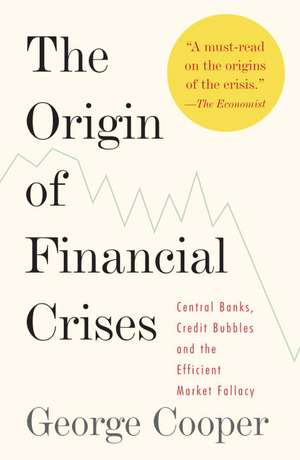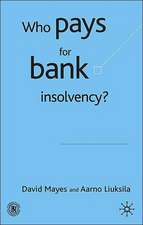The Origin of Financial Crises: Central Banks, Credit Bubbles and the Efficient Market Fallacy
Autor George Cooperen Limba Engleză Paperback – 31 oct 2008
| Toate formatele și edițiile | Preț | Express |
|---|---|---|
| Paperback (2) | 66.89 lei 3-5 săpt. | |
| HARRIMAN HOUSE LTD – 29 iun 2010 | 66.89 lei 3-5 săpt. | |
| Vintage Books USA – 31 oct 2008 | 93.18 lei 3-5 săpt. | +43.05 lei 10-14 zile |
Preț: 93.18 lei
Nou
17.83€ • 18.55$ • 14.72£
Carte disponibilă
Livrare economică 22 martie-05 aprilie
Livrare express 11-15 martie pentru 53.04 lei
Specificații
ISBN-10: 0307473457
Pagini: 194
Dimensiuni: 131 x 203 x 15 mm
Greutate: 0.27 kg
Editura: Vintage Books USA
Notă biografică
Extras
The first years of this millennium were marred with a corporate credit crisis; this being the hangover of a credit binge associated with the stock market boom of the late 1990s. Just as this crisis ebbed we found ourselves engulfed in a housing boom and, sure as night follows day, this boom has now morphed into its inevitable credit crunch. The proximity of these boom-bust cycles has fuelled the popular perception that financial crises are becoming larger and more frequent. The following chapters will explain why this popular perception is correct.
Toward the end of the book I make some policy suggestions that, it is hoped, could begin to dampen the current chain of overlapping boombust cycles. The overall thrust of these suggestions is that avoiding the financial tsunamis comes at the price of permitting, even encouraging, a greater number of smaller credit cycles. And also at the price of requiring central banks to occasionally halt credit expansions. That is to say, the central banks must be required to prick asset price bubbles. Key to the success of any such policy will be a political climate that accepts the need for symmetric monetary policy; excessive credit expansion should be fought with the same vigour as is used to fight excessive credit contraction. As things stand neither politicians nor voters are ready for such tough love and central bankers have neither the stomach nor inclination to deliver it. In large part this is because economists have taught us that it is unwise and unnecessary to combat asset price bubbles and excessive credit creation. Even if we were unwise enough to wish to prick an asset price bubble, we are told it is impossible to see the bubble while it is in its inflationary phase.We are told, however, that by some unspecified means the bubble's camouflage is lifted immediately as it begins deflating, thereby providing a trigger for prompt fiscal and monetary stimulus.
In recent years this lopsided approach to monetary and fiscal policy has been further refined into what has been described as a “risk management paradigm”, whereby policy makers attempt to get their retaliation in early by easing policy in anticipation of an economic slowdown, even before firm evidence of the slowdown has been accumulated. This strategy is perhaps best described as pre-emptive asymmetric monetary policy.
To followers of orthodox economic theory, based on the presumption of efficient financial markets, this new flavour of monetary policy can be justified. Yet, current events suggest these asymmetric policies have gone badly wrong, leading not to a higher average economic growth rate, as was hoped, but instead to a an unsustainable level of borrowing ending in abrupt credit crunches.
1.2 Efficient Markets – More Faith Than Fact
The bare outlines of a competitive profit-and-loss system are simple to describe. Everything has a price — each commodity and each service. Even the different kinds of human labor have prices, usually called 'wage rates.'
Everybody receives money for what he sells and uses this money to buy what he wishes. If more is wanted of any one good, say shoes, a flood of new orders will be given for it. This will cause its price to rise and more to be produced. Similarly, if more is available of a good like tea than people want, its price will be marked down as a result of competition. At the lower price people will drink more tea, and producers will no longer produce so much. Thus equilibrium of supply and demand will be restored.
What is true of the markets for consumers' goods is also true of markets for factors of production such as labor, land, and capital inputs.
—Paul A Samuelson
Who could possibly argue with the above passage? It was written by one of the world's most respected economists and is no more than a statement of the common-sense principle of supply and demand. When the demand for a particular product goes up, so does its price, which is then followed by an increase in supply. According to this theory, prices jostle up and down keeping supply and demand in perfect balance.With just a little more thought we can stretch the argument further and convince ourselves not only that this process generates a stable equilibrium state, but that it also ensures the best possible arrangement of prices, leading to the optimal allocation of resources; if a better, more-economically productive, allocation of resources could be achieved, then those able to make better use of the resources would be able to pay more for them, causing prices to change accordingly. Naturally, if markets tend toward an optimal arrangement of prices, with the most productive allocation of resources, this configuration must also be a stable equilibrium situation. The upshot of all of this is what is known as the laissez-faire2 school of economic theory, which argues that market forces be given free rein to do as they choose. The logic of the laissez-faire school being that, if free markets naturally achieve an optimal equilibrium, any interference with market forces can at best achieve nothing, but more likely will push the system away from equilibrium toward a sub-optimal state. The prevailing laissez-faire school therefore requires the minimization, even elimination, of all forms of interference with the operation of market processes.
It also follows from the efficient market philosophy that only external adverse shocks are able to push markets away from their natural optimal state, as, by definition, an equilibrium-seeking system cannot internally generate destabilising forces able to push it away from equilibrium.
1.3 A Slight Of Hand
Now re-read Samuelson's passage, only this time look out for the slight of hand in the final sentence:
What is true of the markets for consumers' goods is also true of markets for factors of production such as labor, land, and capital inputs.
The passage provides a convincing explanation of how equilibrium is established in the marketplace for goods, but when it comes to the markets for labour, land and capital inputs, there is no explanation of the mechanisms through which equilibrium is established. For these markets we are offered nothing better than proof by assertion. This logical trick is pervasive in economic teaching: we are first persuaded that the markets for goods are efficient, and then beguiled into believing this to be a general principle applicable to all markets. As the failure of Northern Rock and Bear Stearns show it is unsafe to assume that all markets are inherently stable.
1.4 The Market For Bling
We can easily find a counter example to Samuelson's well-behaved supply-and-demand driven markets. In the marketplace for fine art and luxury goods, demand is frequently stimulated precisely because supply cannot be increased in the manner required for market efficiency: Who would pay $140,000,000 for a Jackson Pollock painting if supply could be increased in proportion to demand? The phrase “conspicuous consumption” was coined by the economist Thorstein Veblen to describe markets where demand rose rather than declined with price. Veblen's theory was that in these markets it was the high price, the publically high price, of the object that generated the demand for it. Veblen argued that the wealthy used the purchase of high-priced goods to signal their economic status.3 Veblen was the original economist of bling — if you've got it you want to flaunt it.
Fortunately for the high priests of market efficiency, Veblen's observations can be dismissed as minor distortions within an overall economic environment that responds in a rational manner to higher prices. That is to say, even at a price of $140,000,000, the market for Jackson Pollock paintings is irrelevant to the wider economy.
1.5 When The Absence Of Supply Drives Demand
While the markets for bling can be dismissed as economically irrelevant, there are other much more important markets which also defy the laws of supply and demand, as described by Samuelson. While Veblen identified the rare conditions in which high prices promoted high demand, we can also consider the much more common situation in which low or falling supply promotes high demand.
Today's oil markets are a case in point, where constrained supply is prompting higher speculative demand. While consumers of oil are reducing their oil purchases in response to supply constraints and higher prices, speculators (investors) in oil are moving in the opposite direction and increasing their purchases.
This simple observation of how consumers and speculators respond in different ways to supply constraints gives us the first hint that a fundamentally different market mechanism operates in the markets for assets to that which dominates the markets for goods and services. This effect is not confined just to today's unusual oil market: Who would invest in the shares of a company if that company were in the habit of issuing more stock whenever its share price rose above a certain level?
As a rule, when we invest we are looking for an asset with a degree of scarcity value, one for which supply cannot be increased to meet demand. Whenever we invest in the hope of achieving capital gains we are seeking scarcity value, in defiance of the core principle that supply can move in response to demand.
To the extent that asset price changes can be seen as a signal of an asset becoming more or less scarce, we can see how asset markets may behave in a manner similar to those of Veblen's market for conspicuous consumption goods. In Veblen's case it is simply high prices that generate high demand, but in asset markets it is the rate of change of prices that stimulates shifting demand.
Frequently in asset markets demand does not stimulate supply, rather a lack of supply stimulates demand. Equally price rises can signal a lack of supply thereby generating additional demand, or, conversely, price falls can signal a glut of supply triggering reduced demand.
1.6 Introducing The Efficient Market Hypothesis
To economists the importance of efficient markets lies not in the markets' pricing mechanism directly, but rather in the ability of the pricing mechanism to maximise economic output via an optimal allocation of resources. To financial professionals the emphasis is more directly on the pricing of the items being traded. Financial theory has refined and extended the implications of market efficiency into an additional set of laws describing how markets must behave as a consequence of their being efficient.
The key message of the Efficient Market Hypothesis is that asset prices are always and everywhere at the correct price. That is to say, today's market prices, no matter what they are, correctly reflect assets' true values, based on both current economic conditions and the best estimate of how those conditions will evolve in the future. According to this financial theory any asset price movement must be generated by external “shocks”. To the efficient market school the constant price changes observed in financial markets are the result of those markets responding to a constant stream of new information.
The Efficient Market Hypothesis has no room for asset price bubbles or busts; under this theory the wild asset price swings commonly referred to as bubbles are nothing more than markets responding to changing fundamentals. People outside of the world of economics and finance may be amazed to know that a significant body of researchers are still engaged in the task of proving that the pricing of the NASDAQ stock market correctly reflected the market's true value throughout the period commonly known as the NASDAQ bubble. To these researchers the NASDAQ Composite Index was correctly priced at 1,140 in March 1996, also correctly priced at 5,048 in March 2000, and again correctly priced when, in October 2002, it had returned to a price of 1,140. The intellectual contortions required to rationalize all of these prices beggars belief, but the contortions are performed, none the less, in the name of defending the Efficient Market Hypothesis.
The idea that markets are always correctly priced remains a key argument against central banks attempting to prick asset price bubbles. Strangely, however, when asset prices begin falling the new lower prices are immediately recognised as being somehow wrong and requiring corrective action on the part of policy makers.
Another interesting result of the Efficient Market Hypothesis is that it can be used to infer the manner in which asset prices move, which in turn allows for the calculation of the entire probability distribution of potential future asset returns. Sadly, these theoretical distributions tend not to fit with the reality of financial markets, which in practice tend to generate extremes of both positive and negative returns that simply cannot be explained with the statistical models derived from the Efficient Market Hypothesis. The clash between the theoretical statistics predicted by efficient markets and those observed within real financial markets is known as the “fat tails” problem.5 One recent example of the fat tail problem occurred with huge losses in one of the world's largest hedge funds. These losses were apparently described by the firm's chief financial officer as resulting from the fund suffering adverse “25-standard deviation events, several days in a row”. It is difficult to convey just how improbable a pair of back-to-back 25-standard deviation losses really is, but by my estimate its probability is roughly:
0.00000000000000000000000000000000000000000000000000000000000000000000000000000000000000000000000000000000000000000000000000000000000000000000000000000000000000000000000000000000000000000000000000000000000000000000000000000000000000000000000000000000000000000000000000000000001.
Statistically speaking, a pair of 25-standard deviation events is not an example of bad luck; it's an example of bad statistics and bad science. Improbabilities such as these properly belong to the realm of Douglas Adams.
Were these claimed 25-standard deviation events unique, it would be possible to gloss over the inconsistencies between real life and theoretical forecasts, but in finance statistical impossibilities are quite literally an everyday occurrence. Each and every day financial markets move in ways that simply cannot be explained by our theories of how these markets work.
Nevertheless, despite overwhelming evidence to the contrary, the Efficient Market Hypothesis remains the bedrock of how conventional wisdom views the financial system, the key premise upon which we conduct monetary policy and the framework on which we construct our financial risk systems.
Recenzii
—The Economist
“A well written book. . . . Cooper's most novel doctrine is that investors do not have to be irrational to generate bubbles. . . . Mr. Cooper traces present difficulties to the rapid growth of credit encouraged by the Fed's ultra-cheap money policy of a few years ago.”
—Financial Times
Cuprins
Preface to the Vintage Editon
Preface to the Original Edition
1. Introduction
2. Efficient Markets and Central Banks?
3. Money, Banks and Central Banks
4. Stable and Unstable Markets
5. Deceiving the Diligent
6. On (Central Bank) Governors
7. Minsky Meets Mandelbrot
8. Beyond the Efficient Market Fallacy
9. Concluding Remarks
Appendix – ‘On Governors’ by J.C. Maxwell
Index
Descriere
'The Origin of Financial Crises' provides a compelling analysis of the forces behind the recent economic crisis. In a series of disarmingly simple arguments George Cooper challenges the core principles of today's economic orthodoxy, explaining why financial markets do not obey the efficient market principles but are instead inherently unstable and habitually crisis prone.First published in the summer of 2008 in the midst of the crisis, the author accurately pinpointed the fundamental problems in policy and economic theory that led to the banking crisis. Now updated to reflect the massive upheavals since then and providing even more forthright opinions, the book is essential reading for anyone looking to find the root cause of our current financial situation.The book describes the evolution of our modern monetary system, explaining along the way how financial instability emerged and why this instability required the development of central banking. Cooper makes the point that misguided faith in the power of free markets has led some central banks to neglect their core role of managing the financial system and instead caused them to pursue policies promoting a series of ever more violent boom-bust cycles. 'The Origin of Financial Crises' calls for a radical shift in central bank strategy, the abandonment of inflation targeting and a paradigm shift in our attitude to economic policy.The reader will also learn about the fundamentals of inflation and discover what policy makers can learn from the designers of the Eurofighter jet and how an obscure paper on steam engines, written in 1868, shows us how to avoid repeating recent monetary policy mistakes.Uniquely, 'The Origin of Financial Crises' presents tangible policy proposals aimed at helping break out of the seemingly endless procession of damaging boom-bust cycles.














